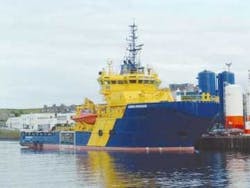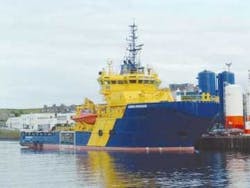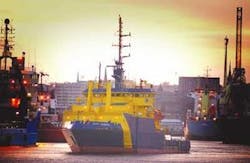North Sea standby model to change following BP/Shell review
This spring, BP announced a new search, rescue, and recovery strategy for its UK operations in the central and northern sectors of the North Sea. The £135-mill-ion program followed three years of trials and consultations with the company's UK off-shore workforce and other interested parties.
BP's stated aim is to replace conventional standby provision with a "regional" approach to search and rescue. This involves the introduction of:
- Four new support vessels, currently under construction in China, equipped with what BP calls "specialized independent" rescue and recovery and fast rescue craft. Three of these will be based in the vicinity of BP's ETAP, Miller, and Magnus platform complexes, with a fourth providing relief and cover for the other three, and also transporting platform supplies
- New state-of-the-art search and rescue helicopters, to be operated by Bond Off-shore Helicopters
- An advanced, platform-based radar system capable of tracking all vessels on each field over a range of 25 nautical mi
- New man-overboard alarms on all platforms that activate if personal locator beacons – to be worn by all the company's offshore crews – are immersed in salt water.
In its early planning stages, the project – known at the time as Jigsaw – had proposed dispensing with standby vessels altogether. That proposal was later modified to vessel-sharing by clusters of offshore installations, following concerns expressed by BP's platform crews. In addition, the downsizing frenzy by the supermajors in general in the North Sea led to rumors of a large-scale exodus. When taken together, these factors dragged investment in new standby vessels to a virtual halt, according to Graham Philip, chief executive of Aberdeen-based BUE Viking.
null
The transfer of mature oil and gas fields to mid-sized independents has helped re-vitalize UK activity, providing new incentives to some vessel operators to re-invest in their fleets. Further momentum has come from the recent resurgence of exploration drilling on the UK continental shelf, and an upsurge in small field developments. "In the short term, this has generated more stability for contractors in terms of continuity of revenue, albeit we are still faced with the peaks and troughs due to the seasonality of drilling activities," Philip says. "In the longer term, however, the gradual reduction in the number of manned installations and the increasing number of installations sharing standby vessels will create further challenges for operators looking to justify new investment."
BUE Viking was formed in September 2002 as a joint venture between BUE Marine and Viking Supply Ships, but with effect from August 2004 is now a wholly owned subsidiary of Viking Supply Ships. The "new" company says it is the market leader in the UK North Sea, with 34 vessels operating out of a 40-strong fleet, and an offshore crew of 750. Turnover is around £40 million/year. "At the moment, our fleet splits into 45% conventional standby vessels, 40% enhanced, and 15% multi-role," Philip says, with an average age of around 25 years, in line with the rest of the market.
Conventional vessels are limited typically to rescue and recovery, providing a place of safety, collision risk monitoring, and radio back-up in emergencies. Enhanced vessels also offer daughter craft, emergency towing, tanker assist, pollution monitoring, and inter-field transfers. Multi-role vessels combine both sets of capabilities with cargo operations and bulk transfer, offshore warehousing, firefighting, and ROV support.
BUE Viking's main clients are BP, Shell, and ChevronTexaco, but it also works for the all the other major North Sea oil companies and the region's growing band of small to mid-sized independents. "What really interests our customers is a combination of high operational and safety standards at the lowest possible cost. All our crews must undergo a variety of safety and rescue training, and all have STCW (Seafarers Standards of Training Certification and Watchkeeping) certification. We also do a lot of ongoing revalidation training and staging of different rescue scenarios, which hopefully will never have to be enacted."
North Star and Boston Putford are the company's chief competitors. The latter, based in Lowestoft, dominates the UK southern gas basin, operating more of an integrated logistics/recovery service, according to Philip. "That's also what BP is trying to do with Jigsaw, but the geography in the northern sector makes this more difficult, with offshore installations being more spread out. The remote operations West of Shetlands (which is not covered by Jigsaw) for example, has relatively few manned installations, and these may be better served by more sophisticated, enhanced or multi-role vessels.
"The market is segmenting across the UKCS, but we're also seeing more pan-European activity, driven by companies like Shell, which have recently re-structured their operations in Europe. They are now looking at the possibility of having one standby vessel contractor, to manage all of their standby vessels throughout Europe. Additionally, we are seeing an export of North Sea standby best practice to other regions such as West Africa. Although the services provided will be based around rescue and recovery, they will also cover a wide range of field support activities which will differ from region to region."


